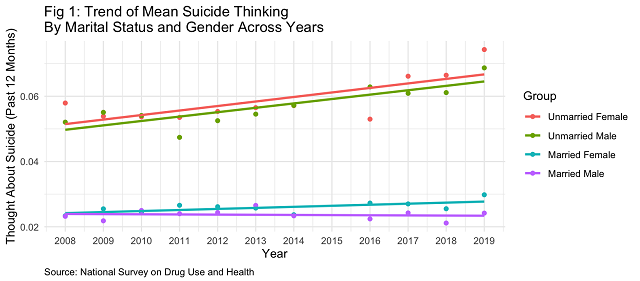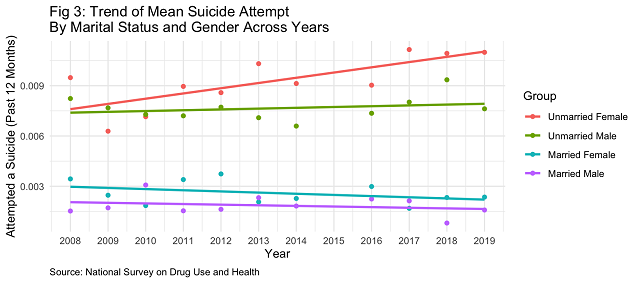Highlights
- Our report found that unmarried individuals were, on average, approximately 3 times more likely than their married counterparts to report suicidal thoughts, plans, or attempts Post This
- This “marriage advantage” has grown significantly over the past decade, driven by the rising suicide risk of those who are not married. Post This
- Unmarried individuals have experienced an increasing risk of suicidal thoughts, plans, or attempts at a rate of about 4-6% per year, compared to their married counterparts. Post This
Suicide is a pressing public health challenge in the United States. In 2023 alone, almost 50,000 Americans died by suicide. Unfortunately, this number has been growing for over two decades. Dating back to Emile Durkheim, marriage has long been known to be protective against suicide. However, given that many facets of marriage and culture have changed considerably over the past decades, we sought to examine whether this well-documented protective association between marriage and the risk for suicidal thoughts and behaviors has changed. To do so, we analyzed over a decade of data (2008-2019) from the National Survey on Drug Use and Health (NSDUH).
Our report, published recently in the Journal of Affective Disorders, found that unmarried individuals were, on average, approximately three times more likely than their married counterparts to report suicidal thoughts, plans, or attempts (see Figures 1 to 3 below).
This association held even after adjusting for a wide range of demographic and socioeconomic factors, including age, sex, race, income, education, and religious attendance.

Moreover, this “marriage advantage” has grown significantly over the past decade, a trend driven by the rising risk of those who are not married. While suicide-related outcomes among married individuals remained relatively flat from 2008 to 2019, the risk among unmarried individuals—especially those who have never married—increased steadily.

Overall, those who are unmarried have experienced an increasing risk of suicidal thoughts, plans, or attempts at a rate of about 4-6% per year (during the time period examined), compared to their married counterparts.

The Rise of the Never-Married Risk
Interestingly, the risk for suicidal thoughts, plans, or attempts remained stable or even declined slightly among divorced or widowed individuals. However, those who have never married experienced an increase in suicidal thoughts, plans, and attempts over time.
We considered whether the growing marriage gap in suicide risk could be explained by other factors, such as income or religiosity. While both are associated with lower suicide risk generally, neither fully accounted for the protective effect of marriage. Even after including these variables in the regression models, married individuals were significantly less likely to report suicidal ideation or behavior.
This trend is particularly concerning given broader cultural shifts. Marriage rates have declined significantly in recent decades, especially among those with lower levels of education and income. Among young adults today, only 20% say that being married is “very important” to living a fulfilling life. Some experts, including the U.S. Surgeon General, warn that Americans are experiencing a ‘loneliness epidemic,’ though there is not broad agreement on how this should best be addressed.
Implications for Treatment, Culture, and Policy
These findings have important implications for clinicians, policymakers, and society at large. First, those who have never married may warrant special consideration by clinicians. Our findings also raise important questions about the broader devaluation of marriage in American culture. As marriage has become less common and more delayed, especially among younger and lower-income Americans, a key source of psychological resilience (not to mention meaning, purpose, and happiness) has steadily eroded.
In an era where marriage is often portrayed as optional or even outdated, our findings suggest that it still plays a vital role in promoting mental health and well-being. As we continue to grapple with rising rates of suicide and psychological distress, we must consider how social structures—including marriage—can serve as protective factors.
Samuel T. Wilkinson is Associate Professor at the Yale School of Medicine and the Medical Director of the Yale Depression Research Program. He is a fellow at the Wheatley Institute (BYU) and the author of Purpose: What Evolution and Human Nature Imply About the Meaning of Our Existence. Stephen Cranney is a nonresident fellow at Baylor University’s Institute for the Studies of Religion and is a freelance data scientist operating out of the DC area.
Editor’s Note: This article contains a discussion of suicide. If you or someone you know needs help, the national suicide and crisis lifeline in the U.S. is available by calling or texting 988.











